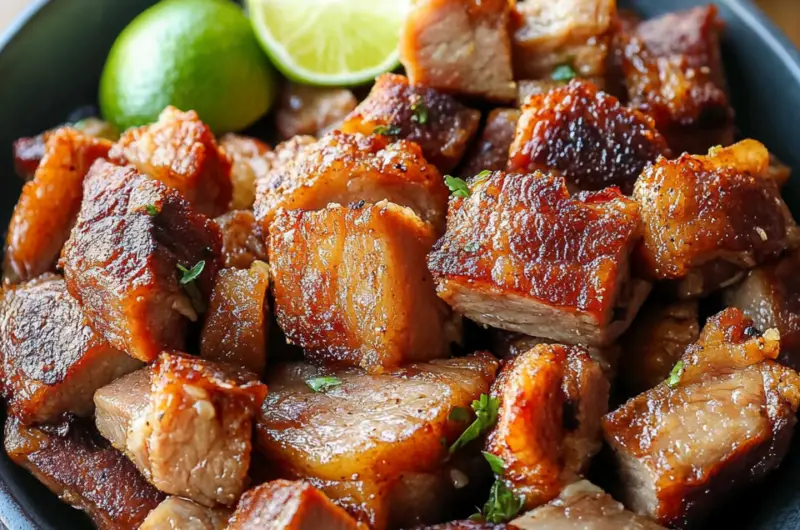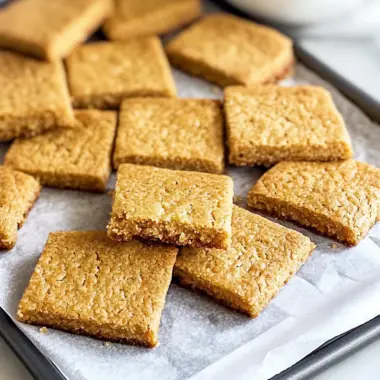The delightful sound of crispy pork chicharrones crackling as they cook is almost as satisfying as that first crunchy bite. A staple in Mexican cuisine, these golden pork belly pieces are deeply rooted in traditional cooking, often made in large batches for family feasts or festive gatherings. With simple seasonings and a time-honored technique, this dish turns humble ingredients into an irresistible snack or main dish. Chicharrones are incredibly versatile and can be enjoyed in a variety of ways wrapped in warm tortillas, crumbled over beans, dipped in zesty salsas, or eaten just as they are. Whether you’re reliving childhood memories or experiencing them for the first time, homemade chicharrones capture the heart of authentic Mexican comfort food with each bite.
Full Recipe:
Ingredients:
-
2 pounds pork belly, skin on
-
1 tablespoon salt
-
2 cups water
-
2 bay leaves
-
1 teaspoon baking soda (optional, for extra crispiness)
-
2 cloves garlic, peeled
-
1 tablespoon white vinegar
Directions:
-
Cut pork belly into bite-sized chunks, keeping the skin intact.
-
Place the pork pieces in a deep, heavy-bottomed skillet or pot.
-
Add water, salt, bay leaves, garlic, and vinegar. Bring to a boil over medium heat.
-
Let the mixture cook uncovered. As water evaporates, the pork fat will render and begin to fry the pork pieces.
-
Continue cooking, occasionally stirring, until the pork becomes golden brown and crispy, about 1 to 1.5 hours.
-
Remove the chicharrones from the pan and place on a paper towel-lined plate to drain excess oil.
-
Let rest for 5–10 minutes before serving. Enjoy with lime wedges, salsa, or tortillas.
Prep Time: 15 minutes | Cooking Time: 1 hour 15 minutes | Total Time: 1 hour 30 minutes
Kcal: 465 kcal | Servings: 6 servings
The Irresistible World of Chicharrones: A Crunchy Mexican Classic
Few foods in Mexican cuisine elicit the universal joy and nostalgia like chicharrones golden, crunchy, and deeply flavorful pieces of fried pork belly. From bustling street markets in Mexico City to humble family kitchens across Latin America, this iconic dish holds a special place in both the culinary and cultural fabric of the region. In this article, we delve into the rich history, techniques, cultural importance, and modern variations of chicharrones, offering a deeper look into why this crispy delicacy continues to charm food lovers around the globe.
What Are Chicharrones?
Chicharrones are traditionally made from pork belly with the skin attached, slowly simmered and rendered until the meat crisps up into delectable golden bites. Though simple in ingredients, the magic of chicharrones lies in the cooking process starting with a slow boil and ending in a sizzling self-fry as the pork releases its own fat. The result is a crispy, crunchy exterior with a melt-in-your-mouth, savory interior that’s hard to resist.
Chicharrones go by many names and interpretations across cultures. In Mexico, they’re often served with lime, salsa, or even hot sauce. Some are paper-thin and crisp, almost like chips, while others are meaty and rich, served as a main dish or snack. This versatility makes chicharrones a truly global comfort food.
A Bite of History
Chicharrones have deep roots not just in Mexico, but across Spain and Latin America. The word chicharrón comes from Spanish and was introduced during colonial times. In Spain, the dish typically referred to fried pork rinds or fatty pork, and when the recipe traveled to the Americas, it evolved based on local ingredients and preferences.
In Mexico, chicharrones became more than just a method of preserving meat it became a cherished snack and meal component. Over the years, regional variations emerged. In some areas, they’re made with beef, mutton, or even chicken. In others, they’re cut thick and hearty, perfect for tacos or stews. The cooking method stayed largely the same, honoring the traditional render-and-fry approach that produces that irresistible crunch.
Why Chicharrones Are So Popular
What makes chicharrones so universally loved? It’s a combination of texture, flavor, and the emotional pull of tradition. The crispy skin and fatty, salty bite create a sensory experience that’s hard to match. Add to that the sound of sizzling pork fat in a pan, the scent of caramelizing meat, and the satisfying crunch when you take a bite it’s culinary ASMR at its finest.
They’re also deeply nostalgic. For many, chicharrones are associated with childhood memories, family gatherings, and festive meals. They’re often cooked in large batches and shared, symbolizing togetherness and celebration. Whether sold in plastic bags on the street, served at food stalls with salsa verde, or brought out during holidays, chicharrones are more than just food they’re a symbol of culture and identity.
Different Ways to Enjoy Chicharrones
One of the joys of chicharrones is their versatility. Here are several popular ways they’re enjoyed across Mexico and beyond:
1. With Salsa and Lime
Perhaps the simplest and most classic way served hot or room temperature, sprinkled with lime juice and dipped into spicy salsa. The acidity of the lime cuts through the richness of the pork, balancing the flavor beautifully.
2. In Tacos
Chicharrones make an excellent taco filling. Combined with soft tortillas, fresh onions, cilantro, and hot sauce, they transform into a street-food classic.
3. Cooked in Green or Red Sauce (Chicharrón en Salsa Verde/Roja)
In this dish, the crispy pork is simmered in a spicy green or red tomato-based sauce, softening slightly while retaining texture. It’s often served with rice and beans.
4. As a Snack or Appetizer
Chicharrones are commonly eaten like chips plain or with chili powder and lime. In this form, they’re great for parties or a quick savory snack.
5. Crumbling Over Dishes
Some people like to crumble them over soups, beans, or even salads for added texture and richness.
Tips for Perfect Chicharrones at Home
Cooking chicharrones at home may sound daunting, but it’s quite achievable with a bit of patience. Here are a few tips to keep in mind:
-
Use Pork Belly with Skin On: This cut offers the ideal ratio of fat to meat, ensuring crispiness and flavor.
-
Simmer First: Begin by simmering the pork in water and salt to tenderize it.
-
Let Fat Render Slowly: Once the water evaporates, the pork will begin to fry in its own fat. This self-rendering technique is key to achieving perfect texture.
-
Add Garlic or Bay Leaves: These aromatics enhance the depth of flavor during cooking.
-
Avoid Overcrowding: Too much meat in the pan can prevent proper crisping. Work in batches if necessary.
Nutritional Considerations
Chicharrones are undeniably rich in fat, but they also offer protein and essential nutrients like iron and zinc. While they may not be an everyday food for health-conscious eaters, they can certainly be enjoyed in moderation as part of a balanced diet.
For those on low-carb or keto diets, chicharrones are actually a popular snack because they’re naturally free from carbohydrates. When prepared simply, without added starches or sugars, they align well with high-fat, low-carb meal plans.
Chicharrones Across Cultures
Chicharrones might be quintessentially Mexican, but they are loved in various forms across the globe:
-
Philippines: Known as chicharon, usually eaten as a snack or with vinegar dipping sauce.
-
Spain: The birthplace of the dish, where they’re often served with beer or wine.
-
Colombia and Venezuela: Typically thicker and meatier, served with arepas or rice.
-
United States: Often found as pork rinds in bags at gas stations or grocery stores, a popular crunchy snack.
Each culture adds its own twist, making chicharrones a truly international favorite.
Modern Twists and Creative Uses
As with many traditional dishes, modern chefs have started putting their own spins on chicharrones. Here are a few creative ideas:
-
Crushed as a Crust: Use chicharrón crumbs to coat chicken or fish for a crispy outer layer.
-
Chicharrón Nachos: Replace tortilla chips with crispy chicharrones for a decadent appetizer.
-
In Fusion Tacos: Pair with unexpected ingredients like kimchi, pickled onions, or mango salsa.
-
Garnish for Bloody Marys: Add flair and crunch to brunch cocktails.
These innovations maintain the soul of the dish while exploring new flavor combinations.
Conclusion:
Chicharrones are far more than just crispy pork they’re a celebration of flavor, texture, and tradition. Whether you grew up eating them or are discovering them for the first time, making chicharrones at home is a rewarding way to connect with Mexican culinary heritage.
Their simplicity belies their complexity. With just a few ingredients and a bit of time, you can recreate this timeless classic and impress your friends and family. From tacos to snacks, from classic to contemporary, chicharrones continue to win hearts one crunchy bite at a time.







